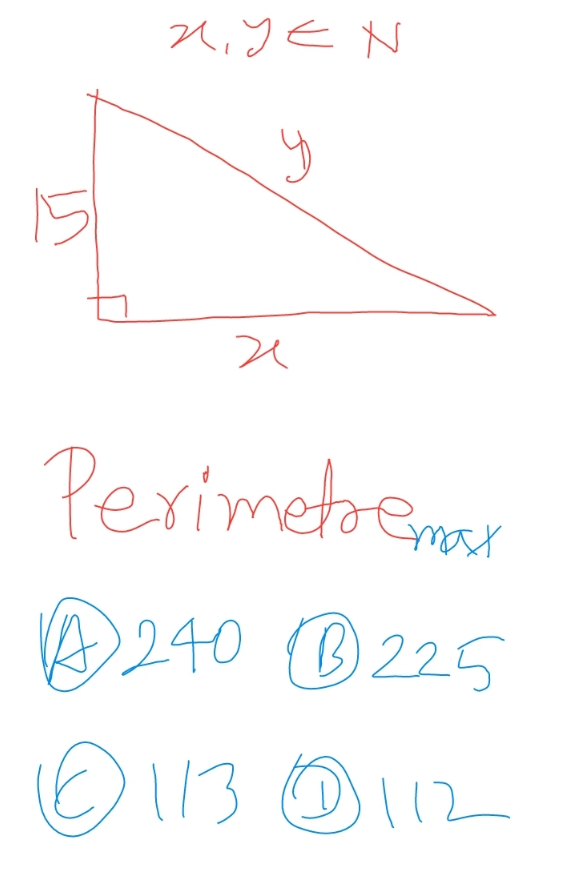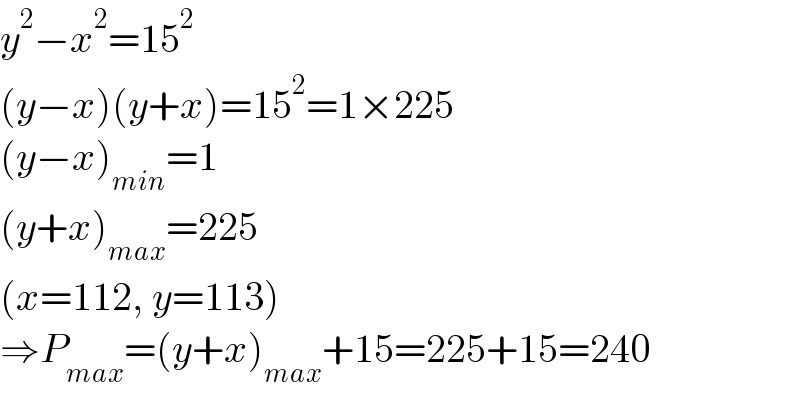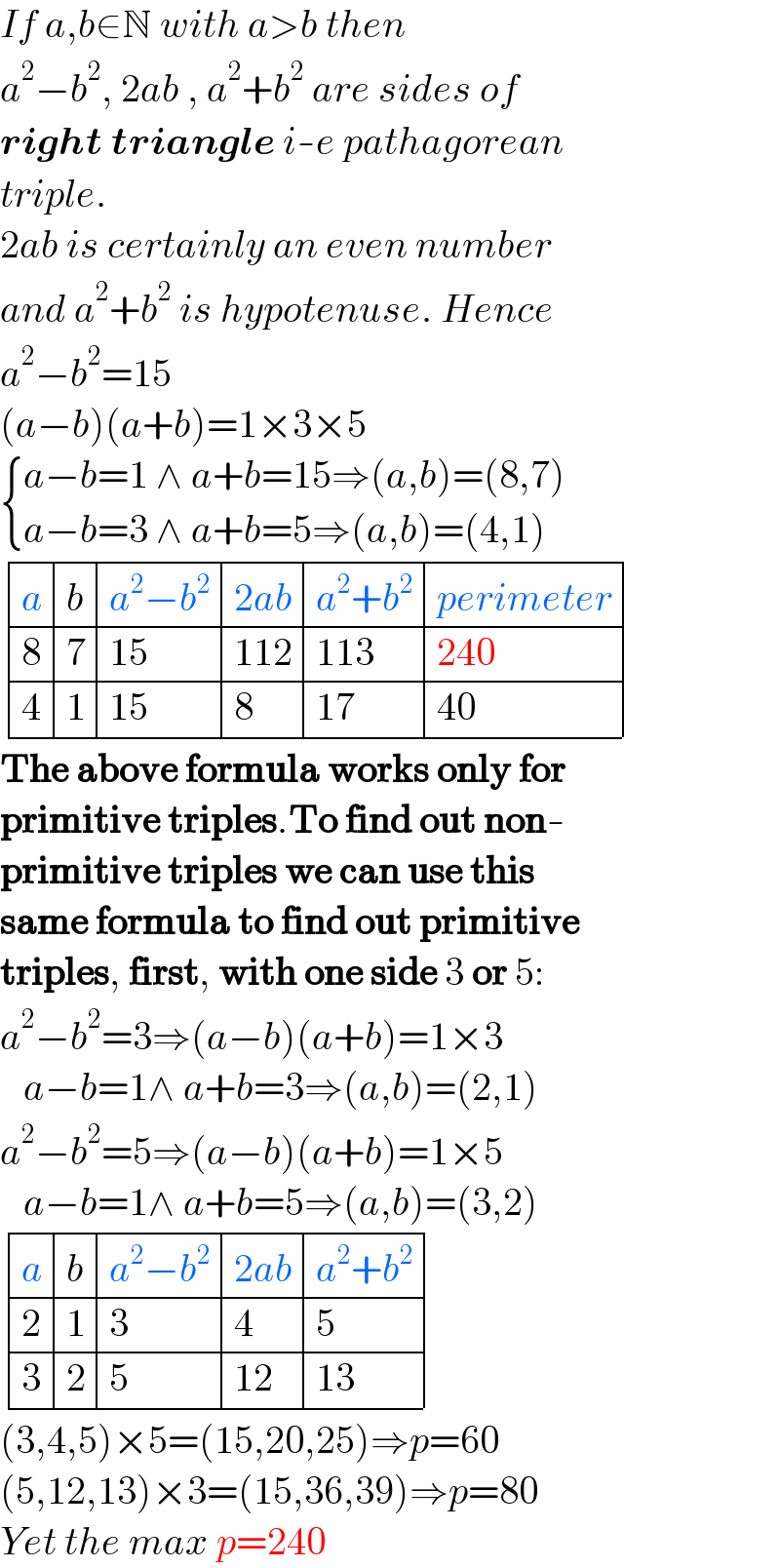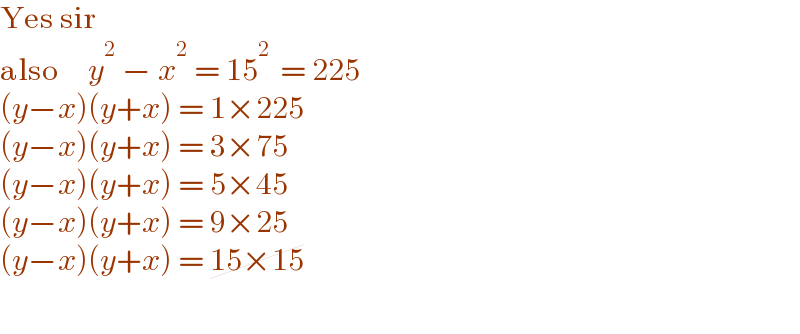
Question Number 205062 by BaliramKumar last updated on 07/Mar/24

Answered by cortano12 last updated on 07/Mar/24

$$\:\:\mathrm{P}_{\mathrm{max}} \:=\:\mathrm{240}\: \\ $$
Commented by BaliramKumar last updated on 07/Mar/24

$$\mathrm{solution} \\ $$
Answered by mr W last updated on 07/Mar/24

$${y}^{\mathrm{2}} −{x}^{\mathrm{2}} =\mathrm{15}^{\mathrm{2}} \: \\ $$$$\left({y}−{x}\right)\left({y}+{x}\right)=\mathrm{15}^{\mathrm{2}} =\mathrm{1}×\mathrm{225} \\ $$$$\left({y}−{x}\right)_{{min}} =\mathrm{1} \\ $$$$\left({y}+{x}\right)_{{max}} =\mathrm{225} \\ $$$$\left({x}=\mathrm{112},\:{y}=\mathrm{113}\right) \\ $$$$\Rightarrow{P}_{{max}} =\left({y}+{x}\right)_{{max}} +\mathrm{15}=\mathrm{225}+\mathrm{15}=\mathrm{240} \\ $$
Commented by BaliramKumar last updated on 07/Mar/24

$$\mathrm{thanks} \\ $$
Answered by Rasheed.Sindhi last updated on 07/Mar/24

$${If}\:{a},{b}\in\mathbb{N}\:{with}\:{a}>{b}\:{then} \\ $$$${a}^{\mathrm{2}} −{b}^{\mathrm{2}} ,\:\mathrm{2}{ab}\:,\:{a}^{\mathrm{2}} +{b}^{\mathrm{2}} \:{are}\:{sides}\:{of} \\ $$$$\boldsymbol{{right}}\:\boldsymbol{{triangle}}\:{i}-{e}\:{pathagorean} \\ $$$${triple}. \\ $$$$\mathrm{2}{ab}\:{is}\:{certainly}\:{an}\:{even}\:{number} \\ $$$${and}\:{a}^{\mathrm{2}} +{b}^{\mathrm{2}} \:{is}\:{hypotenuse}.\:{Hence} \\ $$$${a}^{\mathrm{2}} −{b}^{\mathrm{2}} =\mathrm{15} \\ $$$$\left({a}−{b}\right)\left({a}+{b}\right)=\mathrm{1}×\mathrm{3}×\mathrm{5} \\ $$$$\begin{cases}{{a}−{b}=\mathrm{1}\:\wedge\:{a}+{b}=\mathrm{15}\Rightarrow\left({a},{b}\right)=\left(\mathrm{8},\mathrm{7}\right)}\\{{a}−{b}=\mathrm{3}\:\wedge\:{a}+{b}=\mathrm{5}\Rightarrow\left({a},{b}\right)=\left(\mathrm{4},\mathrm{1}\right)}\end{cases} \\ $$$$\begin{array}{|c|c|c|}{{a}}&\hline{{b}}&\hline{{a}^{\mathrm{2}} −{b}^{\mathrm{2}} }&\hline{\mathrm{2}{ab}}&\hline{{a}^{\mathrm{2}} +{b}^{\mathrm{2}} }&\hline{{perimeter}}\\{\mathrm{8}}&\hline{\mathrm{7}}&\hline{\mathrm{15}}&\hline{\mathrm{112}}&\hline{\mathrm{113}}&\hline{\mathrm{240}}\\{\mathrm{4}}&\hline{\mathrm{1}}&\hline{\mathrm{15}}&\hline{\mathrm{8}}&\hline{\mathrm{17}}&\hline{\mathrm{40}}\\\hline\end{array}\: \\ $$$$\boldsymbol{\mathrm{The}}\:\boldsymbol{\mathrm{above}}\:\boldsymbol{\mathrm{formula}}\:\boldsymbol{\mathrm{works}}\:\boldsymbol{\mathrm{only}}\:\boldsymbol{\mathrm{for}} \\ $$$$\boldsymbol{\mathrm{primitive}}\:\boldsymbol{\mathrm{triples}}.\boldsymbol{\mathrm{To}}\:\boldsymbol{\mathrm{find}}\:\boldsymbol{\mathrm{out}}\:\boldsymbol{\mathrm{non}}- \\ $$$$\boldsymbol{\mathrm{primitive}}\:\boldsymbol{\mathrm{triples}}\:\boldsymbol{\mathrm{we}}\:\boldsymbol{\mathrm{can}}\:\boldsymbol{\mathrm{use}}\:\boldsymbol{\mathrm{this}} \\ $$$$\boldsymbol{\mathrm{same}}\:\boldsymbol{\mathrm{formula}}\:\boldsymbol{\mathrm{to}}\:\boldsymbol{\mathrm{find}}\:\boldsymbol{\mathrm{out}}\:\boldsymbol{\mathrm{primitive}} \\ $$$$\boldsymbol{\mathrm{triples}},\:\boldsymbol{\mathrm{first}},\:\boldsymbol{\mathrm{with}}\:\boldsymbol{\mathrm{one}}\:\boldsymbol{\mathrm{side}}\:\mathrm{3}\:\boldsymbol{\mathrm{or}}\:\mathrm{5}: \\ $$$${a}^{\mathrm{2}} −{b}^{\mathrm{2}} =\mathrm{3}\Rightarrow\left({a}−{b}\right)\left({a}+{b}\right)=\mathrm{1}×\mathrm{3} \\ $$$$\:\:\:{a}−{b}=\mathrm{1}\wedge\:{a}+{b}=\mathrm{3}\Rightarrow\left({a},{b}\right)=\left(\mathrm{2},\mathrm{1}\right) \\ $$$${a}^{\mathrm{2}} −{b}^{\mathrm{2}} =\mathrm{5}\Rightarrow\left({a}−{b}\right)\left({a}+{b}\right)=\mathrm{1}×\mathrm{5} \\ $$$$\:\:\:{a}−{b}=\mathrm{1}\wedge\:{a}+{b}=\mathrm{5}\Rightarrow\left({a},{b}\right)=\left(\mathrm{3},\mathrm{2}\right) \\ $$$$\begin{array}{|c|c|c|}{{a}}&\hline{{b}}&\hline{{a}^{\mathrm{2}} −{b}^{\mathrm{2}} }&\hline{\mathrm{2}{ab}}&\hline{{a}^{\mathrm{2}} +{b}^{\mathrm{2}} }\\{\mathrm{2}}&\hline{\mathrm{1}}&\hline{\mathrm{3}}&\hline{\mathrm{4}}&\hline{\mathrm{5}}\\{\mathrm{3}}&\hline{\mathrm{2}}&\hline{\mathrm{5}}&\hline{\mathrm{12}}&\hline{\mathrm{13}}\\\hline\end{array} \\ $$$$\left(\mathrm{3},\mathrm{4},\mathrm{5}\right)×\mathrm{5}=\left(\mathrm{15},\mathrm{20},\mathrm{25}\right)\Rightarrow{p}=\mathrm{60} \\ $$$$\left(\mathrm{5},\mathrm{12},\mathrm{13}\right)×\mathrm{3}=\left(\mathrm{15},\mathrm{36},\mathrm{39}\right)\Rightarrow{p}=\mathrm{80}\: \\ $$$${Yet}\:{the}\:{max}\:{p}=\mathrm{240} \\ $$
Commented by BaliramKumar last updated on 07/Mar/24

$$\mathrm{thanks} \\ $$$$\mathrm{i}\:\mathrm{think}\:\mathrm{4}\:\mathrm{integral}\:\mathrm{side}\:\mathrm{triangles}\:\mathrm{possible} \\ $$$$ \\ $$
Commented by Rasheed.Sindhi last updated on 07/Mar/24

$${Yes}\:{sir},\:{I}'{ve}\:{extended}\:{my}\:{answer}\:{to} \\ $$$${cover}\:{all}\:{possible}\:{triples}\:{now}. \\ $$
Commented by BaliramKumar last updated on 07/Mar/24

$$\mathrm{Yes}\:\mathrm{sir} \\ $$$$\mathrm{also}\:\:\:\:\:{y}^{\mathrm{2}} \:−\:{x}^{\mathrm{2}} \:=\:\mathrm{15}^{\mathrm{2}\:} \:=\:\mathrm{225} \\ $$$$\left({y}−{x}\right)\left({y}+{x}\right)\:=\:\mathrm{1}×\mathrm{225} \\ $$$$\left({y}−{x}\right)\left({y}+{x}\right)\:=\:\mathrm{3}×\mathrm{75} \\ $$$$\left({y}−{x}\right)\left({y}+{x}\right)\:=\:\mathrm{5}×\mathrm{45} \\ $$$$\left({y}−{x}\right)\left({y}+{x}\right)\:=\:\mathrm{9}×\mathrm{25} \\ $$$$\left({y}−{x}\right)\left({y}+{x}\right)\:=\:\cancel{\mathrm{15}×\mathrm{15}} \\ $$$$ \\ $$
Commented by Rasheed.Sindhi last updated on 08/Mar/24

$${An}\:{easy}\:{way}! \\ $$
